Formation of solitary structures and envelope solitons in electron acoustic wave in inner magnetosphere plasma with suprathermal ions
Funding information: Government General Degree College, Jadavpur University
Abstract
The propagation of electron acoustic solitary waves is investigated in magnetized two-temperature electron plasma with supra-thermal ion. By using the reductive perturbation technique, the Korteweg de-Vries (KdV) equation is derived. Later solving this equation, a solitary wave solution has been derived. These are mainly in astrophysical plasmas where changes of local charge density, temperature, and energy of particles produce considerable effects on the plasma system. The effects of supra-thermality, density, and Mach number on solitary structures are studied in detail. The results show that the supra-thermal index (κ) and ion to electron temperature ratio (σ) alters the regime where solitary waves may exist. While studying the solitary profile for different parametric variation some interesting conclusion can be drawn; it is shown that the solitary profile becomes flatter. This can be due to the thermal energy associated with the hot electrons. However, with the increase in ion density with respect to the cold electrons' density, the solitary waves become steeper and sharper. This is due to the comparatively heavier mass of ions. The density of cold electron also increases the solitary structures in a similar manner. The higher the density of cold electrons, sharper will be the profile. The above findings will be helpful in understanding many astrophysical phenomena and data obtained by space missions. For a further study, we keep the investigation of the formation of other kinds of stationary structures like shocks, double layers, etc.




